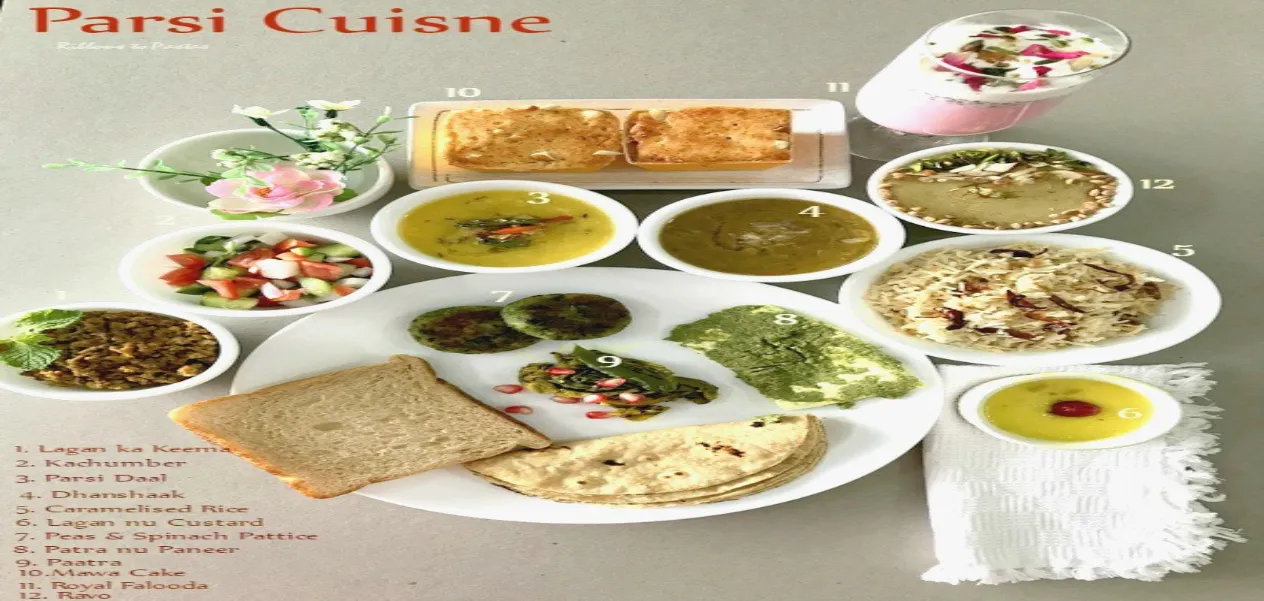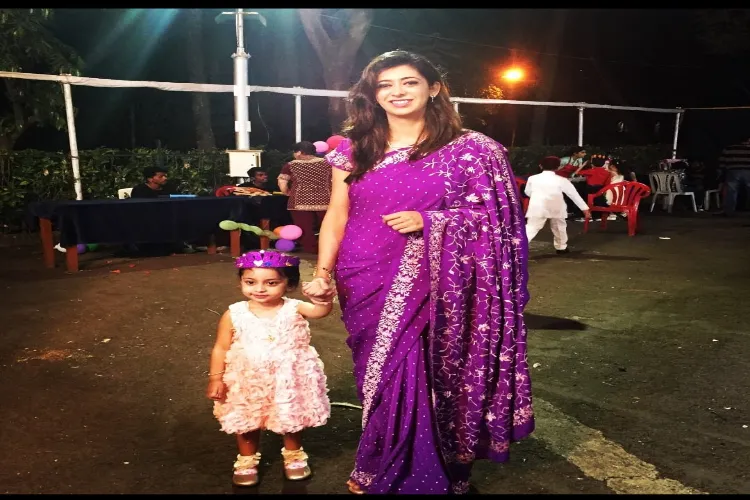
Rumana Vachha Menon/ Kolkata (West Bengal)
I come from a family of good cooks. My grand-mother Khorshed Vachha was an excellent cook and baker. My mother, Nasreen also turned out to be a superb cook. Watching all these ladies working so efficiently in the kitchen and getting enormous encouragement from my grand-mother, I grew up to become a caterer and a baker. I can prepare meals for 20-30 people at a time. I am doing well in my baking business which I started six years back but my day is not complete unless I make a Parsi dish.
I must cook a Parsi dish every day no matter which part of the world I am in. From the time I got married over a decade back, I have joined my husband Abhishek Menon, resident manager with a leading hotel, on his postings in Mumbai, Delhi, Goa and Kolkata but I have kept my Parsi cooking tradition alive 24/7.
Parsi cuisine refers to the traditional cuisine of the Parsi people who had migrated into the Indian subcontinent from Persia, and currently spread across India and Pakistan. The Parsis believe in good food, good health and good life.
The dominant flavours in Parsi food are spicy, sour and sweet. The Parsis call these flavours khattu-meethu.
Parsi cooking uses premium ingredients like saffron and cinnamon which give the dishes a unique taste.
I worked in Hyderabad for six years in the sales department of a leading hotel. When my daughter was born, my priorities changed. I am able to manage things well at home with prior orders. It is a blessing that I am able to use some of my grandmother’s recipes. Baking gives me a lot of pleasure and satisfaction.
There are some memories of childhood that I really cherish. My parents, my brother and I lived in a lovely old bungalow in Hyderabad with my paternal grandmother. I remember my grandmother baking chocolate tarts, coconut tarts, date and walnut cakes for her kitty parties. I would watch her making these amazing freshly baked tarts and making note of her recipes and I still have few of my grandmother's recipes.
I also remember relishing ras chawal. Mori dal, another Parsi staple food, was my favourite.
It is a very simple preparation of boiled pigeon pea/ tur dal with tempering of garlic, cumin seeds , green chillies, coriander and lots of ghee or butter. We make the Mori daal without any tomatoes, onions or ginger. It is served with steamed rice. The Parsis must eat eggs everyday and combine it with any vegetarian dish. We also love stir fry flat beans. For some people, it may be surprising but we add fried egg on top of just about any vegetable. It could be potatoes, okra, brinjals, beans but not on gourds.
Most Parsis love to have mutton and chicken every day. So, living through Covid was a huge challenge for us as it was for everbody. We lived on eggs and vegetables through that phase and swung back to our non vegetarian fare.
The basic feature of a Parsi lunch is rice, eaten with lentils or a curry. Dinner would be a meat dish, often accompanied by potatoes or other vegetable curry. Kachumbar (an onion-cucumber salad) accompanies most meals.
Other Parsi delights are Chicken Farcha (Fried chicken appetizer), Saas ni Maachi (Yellow rice with pomfret fish fillets in white sauce), Kolmi no Patio (Shrimp in spicy potato curry), Jardaloo Sali Boti (boneless mutton in onion and tomato sauce with apricots and matchstick potatoes), Khichri (rice with toor dal) or Moong dal) and Tamota ni Ras Chaval (mutton cultlets with white rice and tomato sauce)
Every Parsi household has simple Indian spices, some of which are the essential Parsi spice blends like Parsi powderd dhana (dhania) jeera (Gujarati for coriander and cumin, dhana zeera). This is used in many Parsi dishes including Dhansak and mutton cutlets. Parsi garam masala comprises cinnamon and nutmeg. If nutmeg is not available, it can be replaced with black peppercorn.
My grandmother prepared dishes using these spices.
Parsi garam masala works wonders with vegetables dishes like titori (sprouted field beans), minced meat and Parsi style meat pulao. Our famous Dhansak masala is used primarily in its namesake, that Parsi treasure, Dhansak. Is used in everything from Bombay duck, cutlets to eggplants. Dhansak masala is a mix of vegetable oil, whole kashmiri Chillies, coriander seeds, cumin seeds and other Indian species.
The Parsi sambar masala is also different from south Indian sambhar powder. Parsi sambar masala is added to dhansak, but it also finds its way into other vegetables and meat dishes such as Dhansak.
My grandmother would pound the spices into smithereens every morning on the stone grinder but we have embraced simpler ways. The cooking tradition was passed on from my great grandmother to my grandmother, then to my mother, to me and now to my nine year old daughter. My daughter got interested in the kitchen when she was barely six years old. She would stand on a stool and insist on cooking on her own, with help of course. She would ask questions and I tried to answer them all.

Rumana with her daughter - a few years back
It is very important for a child, girl or boy to know what is cooking in the kitchen, how to cook it and why a particular dish is being cooked on a certain day. Every Sunday, Dhansak is cooked at home and every Parsi household has a tradition of making meat kabebs with brown caramelized rice. My daughter loves it and she also enjoys Patara ni machhi (Fish - Pomfret or Surmai stuffed with green coconut chutney and wrapped in a banana leaf - steam cooked). Aahaana also bakes banana bread. Carrot cake is her favourite.
Actually, Parsi food is a fusion of Persian, Indian influences and has deep cultural symbolism.
The ingredients and dishes have symbolic significance. For example, eggs hold significant symbolism in Parsi food. They represent fertility, birth and new beginning. One prominent dish 'Akuri' is a special scrambled Eggs preparation.
Ingredients like eggs and rice symbolize new beginning and prosperity, while dishes like Dhansak and Sali boti reflect the heritage of the community and the fact that food not only nourishes our body but also carries with it the rich tapestry of cultural heritage and traditions. One such cuisine that exemplifies this cultural significance is Parsi food.
We also make Sali Marghi (chicken with shredded potatos)
Historical context and migration
The Parsi community traces its origin to ancient Persia, present-day Iran. In the 8th century, faced with religious persecution, a group of Zoroastrians fled Persia and sought refuge on the shores of India and came first to Gujarat. That is how the Parsis adopted the Gujarati culture. This migration known as the flight of the Zoroastrians, marked the beginning of the history of the Parsi community in India. Over time, Parsis assimilated with the local culture while preserving their distinctive traditions, including their cuisine.
Similarly, Dhansak considered the national dish of Parsis, is a stew made with Toor Daal, Masur Dal, Moong Dal and Chana Daal, meat and vegetables. It can also be made without meat. The spices are added at the time of cooking. This dish symbolizes the synthesis in Parsi cuisine. It is mostly prepared on Sunday and represents the connection of the community to their roots.
There are many other dishes like: Sali boti,( meat and potato chips), Patra-ni-Machhi and Masala dal made with Toor dal, Chana dal and Masur dal.
Also popular among Parsis, are the typical Parsi eeda (egg) dishes, which include akuri (scrambled eggs with spices) and the pora ("Parsi" omelette).
Other Parsi snacks include bhakhra (deep fried sweet dough made with semolina, wheat flour and ghee),batasa (tea biscuits made with refined flour), dar ni pori (sweetened lentils stuffed in a light pastry), doodh na puff (milk froth) and khaman na ladva (dumplings stuffed with sweetened coconut).
In the 1930s, traditional breakfasts in Mumbai or in many South Gujarat villages comprised khurchan (offal meats cooked with potatoes in a spicy gravy), and some variant of the ubiquitous deep-fried, fried or half-fried eggs. In agrarian communities, this would be washed down by copious quantities of coconut toddy, often straight off the tree.
On the special occasion of 'Jashan' a Zoroastrian Thanksgiving ceremony in March before the Parsi New Year, a communal meal is shared by the community.
'Jashan Sagan', such as Lagan nu stew( wedding stew) and Langan nu custard ( wedding custard) are prepared at weddings, ‘Jashan’. These dishes symbolize the blessing and unity within the community.
On Navaroz- the Parsi New Year, we make Sali-Boti, Parsi Biryani and pickle made of carrot and raisins. The arrival of a child is celebrated with special boondi ladoos.
(Rumana Vachha Menon is a Kolkata based home baker and specializes in Parsi cooking)
